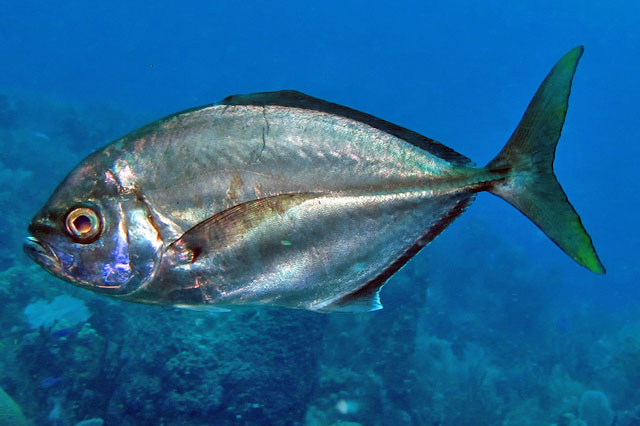Cottonmouth Trevally, Uraspis helvola Forster 1801
Other Names: Basset-hull's Trevally, Cottonmouth Jack, Whitetongue Jack

Cottonmouth Trevally, Uraspis helvola. Source: Mickey Charteris / Shorefishes of the Greater Caribbean online information, http://biogeodb.stri.si.edu/caribbean/en/pages/random/10176. License: CC by Attribution
Summary:
A dark to silvery bluish-black trevally, with a white tongue, roof and floor of mouth, and a scaleless area on the breast that extends about halfway to the pectoral-fin base. Juveniles have a series of broad dark bands with narrow pale interspaces, and sometimes two rows of pale dashes along side.
In Australia, this species was previously known as Uraspis secunda.
In Australia, this species was previously known as Uraspis secunda.
Cite this page as:
Bray, D.J. 2025, Uraspis helvola in Fishes of Australia, accessed 27 Jun 2025, https://fishesofaustralia.net.au/Home/species/1667
Cottonmouth Trevally, Uraspis helvola Forster 1801
More Info
|
Distribution |
Known from scattered localities in Australia, from Exmouth Gulf, Western Australia, around the tropical north to Lakes Entrance, Victoria. Elsewhere the species is widespread in the Indo-Pacific and eastern Atlantic. Individuals or small schools are mostly pelagic or benthopelagic in oceanic waters, although they do occur near the bottom, often around islands. Juveniles often shelter around jellyfish. |
|
Features |
Dorsal fin VII + I, 25-32; Anal fin II+I, 19-23; Gill rakers 3-8 + 13-16. Body oblong, moderately compressed; snout rounded; mouth reaching to below front part of eye; teeth small, pointed, curved, in bands in small fish, in a single row in large fish. First dorsal-fin a low triangle, posterior spines may become embedded with growth; anal-fin spines reduced or absent, first two spines embedded in all but small juveniles; pectoral fins curved, longer than head; caudal peduncle slender, caudal fin strongly forked. Lateral line distinctly arched anteriorly; curved part of lateral line with 48-66 scales, somewhat shorter than the following straight part, straight part with 26-40 scutes, those at rear pointing forwards. Scales absent on breast and pectoral-fin base; operculum partly scaled. |
|
Size |
|
|
Colour |
Body dusky, sometimes with 6 broad dark bars with narrow pale spaces between them; tongue, roof and floor of mouth white, remainder of mouth blue black. the body. |
|
Similar Species |
Differs from the Whitemouth Trevally, Uraspis uraspis, in the scaleless area on the breast that extends about half way to the pectoral-fin base in U. helvola (vs. extends to the pectoral-fin base in U. uraspis), and the curved part of the lateral line is usually shorter that the straight part with 48-66 scales in U. secunda, (vs. curved part of lateral line longer than the straight part, with 61-82 scales in U. uraspis). |
|
Etymology |
The specific name is from the Latin helvolus (= pale brownish yellow), in reference to the colour of this species. |
|
Species Citation |
Scomber helvolus Forster 1801, in Bloch & Schneider, Systema Ichthyologiae: 35.; Type locality: Ascension Island [eastern Atlantic. |
|
Author |
Bray, D.J. 2025 |
|
Resources |
Cottonmouth Trevally, Uraspis helvola Forster 1801
References
Allen, G.R. & Erdmann, M.V. 2024. Reef fishes of the East Indies. 2nd Ed. Volumes I-III. Perth, Australia : Tropical Reef Research.
Forster, J.R. 1801, in Bloch, M.E. & Schneider, J.G. Systema Ichthyologiae Iconibus ex Illustratum. Berlin. 584 pp. See ref at BHL
Gunn, J.S. 1990. A revision of selected genera of the family Carangidae (Pisces) from Australian waters. Records of the Australian Museum, Supplement 12: 1-77 (as Uraspis secunda)
Johnson, G.D. 1978. Development of fishes of the Mid-Atlantic Bight. An atlas of egg, larval and juvenile stages. Vol. 4. Carangidae through Ephippidae. US Fish and Wildlife Service Biol. Serv. Prog. FWS/OBS-78/12. (as Uraspis secunda)
Kimura, S., Takeuchi , S. & Yadome, T. 2022. Generic revision of the species formerly belonging to the genus Carangoides and its related genera (Carangiformes: Carangidae). Ichthyological Research 69(4): 433-487. https://doi.org/10.1007/s10228-021-00850-1
McCulloch, A.R. 1909. Studies in Australian fishes, No. 2. Records of the Australian Museum 7(4): 315-321 fig. 18 pls 90-91. (described as Caranx hullianus, type locality Freshwater Beach, near Sydney, New South Wales)
Smith-Vaniz, W.F. 1999. Family Carangidae. pp. 2659-2756 in Carpenter, K.E. & Niem, T.H. (eds). The Living Marine Resources of the Western Central Pacific. FAO Species Identification Guide for Fisheries Purposes. Rome : FAO Vol. 4 pp. 2069-2790. (as Uraspis secunda)
Smith-Vaniz, W.F. & Williams, I. 2015. Uraspis helvola. The IUCN Red List of Threatened Species 2015: e.T50902942A50912682. https://dx.doi.org/10.2305/IUCN.UK.2015-4.RLTS.T50902942A50912682.en. Accessed on 14 April 2025.
Williams, F. 1961. On Uraspis wakiyai sp. nov. (Pisces, Carangidae), from the western Indian Ocean, with a review of the species of Uraspis Bleeker, 1855, S.S. Annals and Magazine of Natural History (13)4(38): 65-87. (as Uraspis secunda)











